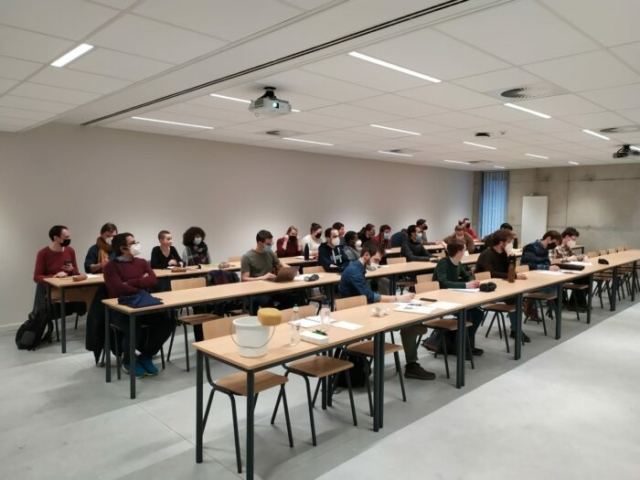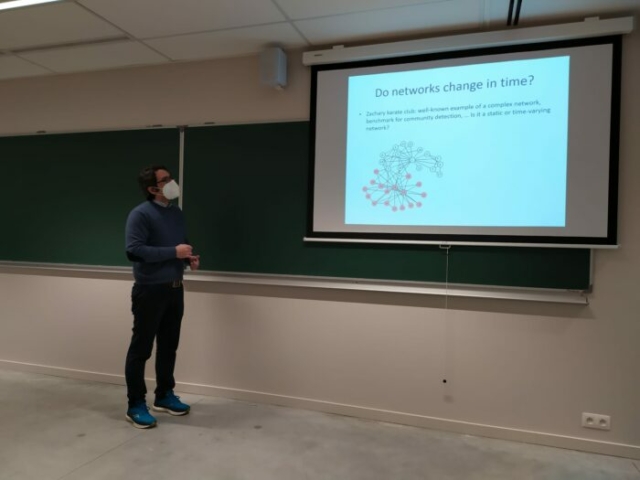
- This event has passed.
FNRS Doctoral School – Introduction to dynamical systems on complex networks
February 1, 2022 @ 09:30 - February 3, 2022 @ 12:45
Doctoral School FNRS – Nonlinear phenomena, complex systems and statistical mechanics
Time: 1-2-3 February 2022 – 9h30-12h45
Location: Université de Namur, Faculty of Science, Room S08
Lecturers: Mattia Frasca (Università di Catania) & Timoteo Carletti (Université de Namur)
Slides:
– Carletti
– Lecture4
– Lecture5
– Lecture6
To attend the lectures it is mandatory to be in possession of the Covid Safe Ticket (CST)
Abstract: We live in an interconnected world, where “basic” units interact each other to produce unexpected emergent behaviors. Our society is for instance, the result of the interaction of many agents, we the human beings, that exchange information, news, opinions, etc., but also likes on Facebook or viruses. To a larger scale, the societies can be considered as agents interacting each other on a global stage, by exchanging goods to create the global economy, or fight each other and thus determine conflicts and wars. Our brain is made of about 100 billions of cells, i.e., the neurons, connected through even more synapses (millions of billions) allowing the signals to pass from one neuron to the others, and thus allowing us to think, act, remember, … Finally, our body is made by about 30 thousand billions of cells, basic blocks that determine our behavior, via synchronized processes, resulting from the exchanges among the cells. The cells are also organized into tissues and organs and so on to allow us to be alive. The following questions emerge thus straightforwardly. Is it possible to understand the behavior of a society ? How to understand the brain functioning, to distinguish between its regular or irregular behavior (disease) and thus control it to reduce / remove the unwanted behavior ? Can we determine the behavior of (part of) the human body? By using a reductionist approach we will divide the system into its constituting “elementary” parts, work hard to understand their behavior and then finally scale up the results to have a global picture. This approach has provided excellent results in many relevant cases (e.g., particle physics) but in other occasion it has shown its limits. A complementary approach is based on the study of the evolution of some average quantities, i.e., the mean field approach; this approach has been largely used in these last months to study the spreading of the COVID-19, i.e., the epidemic models SIR, where you group together all the agents with the same feature, being S, I or R, and you no longer make a distinction among each single agent. Modeling is always a matter of obtaining a reasonable trade-off between the details added to the model and its predictive or descriptive power; hence the level of details you add to a model depends on the research question you are dealing with. It is clear that in the above examples, reductionist or mean field, may fail to sufficiently well describe the whole system, indeed the resulting global behavior is not easily ascribed / predicted from the behavior of each single unit. How would it be possible from the behavior of a single human to extract the behavior of a society? Or, does a neuron has memory? To cope with these issues, network science and complex systems offer a reliable alternative approach. Let us observe that this is not a completely new research field. Physicists have been used it since long time but relying on regular couplings, e.g., the Ising model on square lattices. Nowadays the emphasis is on the use of coupling, i.e., networks, that better represent the reality; often such networks have been directly extracted from real data and thus the results better explain the empirical findings. The goal of these lectures is to propose a (personal) view of some interesting research questions arising once dealing with interconnected systems; we will in particular be interested in the study of the emergence of synchronous behavior or on the other hand of patchy, i.e. spatially heterogeneous, solutions. In the first part of these series of lectures, we will survey some basic results of dynamical systems theory, i.e., equilibria, their stability and bifurcation. The details provided in this first part will depend on the background of the students attending the lectures. Some notions of network theory will be provided and some of the most used models of network will be introduced and characterized (e.g., Erdős-Rényi, Small World, Scale Free). We will then introduce two interesting coupling among the basic units constituting the system, long range interaction and diffusive-like interaction. Starting from the behavior of the single isolated units we will study how the coupling will affect the global behavior and in particular the conditions ensuring the emergence of patchy solutions. We will conclude our lectures with some recent generalizations of network theory, where more complex structures have been considered to go beyond the pairwise interaction modeled by the network theory, e.g., multilayer networks, temporal networks and hypergraphs. The second part of the course will focus on synchronization of regular and chaotic dynamical systems defined on top of complex networks and on graph-based methods for multiagent systems. The major tool for the study of the stability of synchronization in complex networks (i.e., the master stability function) will be presented and then applied to paradigmatic examples. Then, synchronization in time-varying networks will be discussed. This is a particularly relevant case study where links may adapt in time as it occurs in many natural systems in response to different external conditions. The extension of the master stability function to such framework will be discussed and relevant examples of synchronization in adaptive networks and in networks of mobile agents will be dealt with. Finally, the course will discuss graph-based methods for multi-agent systems. In particular, typical multi-agent problems such as rendez-vous and formation control will be considered and solutions based on graph methods will be illustrated. Attention will be given to the communication protocols to set in order to reach the goals of the control, to the formalization of appropriate consensus methods to address these problems, and to simple models of interacting robots. This interdisciplinary doctoral course is aimed at PhD and Master students of nonlinear dynamics and complex system; because of the presented subjects and of the possible applications, students from physics, biology, chemistry or economics are warmly invited to attend the lectures. Some basic mathematical knowledge is required, however the topics will be introduced such in a way that it can be understandable and enjoyable by every researcher interested in collective dynamics and complexity, with more focus on the bigger picture and less on technical details.
For any information, write to riccardo.muolo@unamur.be





